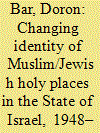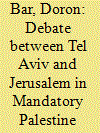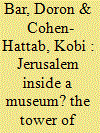|
|
|
Sort Order |
|
|
|
Items / Page
|
|
|
|
|
|
|
| Srl | Item |
| 1 |
ID:
192287


|
|
|
|
|
| Summary/Abstract |
Over the past seven decades, dozens of Muslim holy places in Israel have undergone a process of Judaization, becoming an integral part of the Israeli-Jewish sacred landscape. The current paper compares three waves of Judaization that followed the 1948 and 1967 wars, emphasizing the institutional and popular character of this process. The appropriation of Muslim holy places and their conversion is tied to the political, social, and religious changes that Israeli society underwent during its seventy years of existence. During these decades, Jewish holy spaces gained social, cultural, and religious importance; visiting them became a popular pastime. As the demand for holy places grew, former Muslim sites were converted and became part of Jewish sacred space. The process of transformation took place in parallel on two planes – the institutional and the popular – as both Israeli governmental bodies and worshipers converted Muslim holy places into Jewish sacred sites. The outcome of the process was the expansion of sacred space in the State of Israel and the inclusion of the periphery, which in many cases contained former Muslim holy places, as an integral part of the Jewish map of holy places.
|
|
|
|
|
|
|
|
|
|
|
|
|
|
|
|
| 2 |
ID:
141609


|
|
|
|
|
| Summary/Abstract |
During the Mandate era a custom of re-interment of Jewish thinkers and leaders developed. These were mostly Zionists leaders and ideologists who passed away in the Diaspora and their remains were brought to be buried in Palestine. The article deals with the conflict between Tel Aviv and Jerusalem on the right to re-inter within their boundaries Zionist leaders such as Theodor Herzl, Max Nordau, Leo Motzkin and Yehuda Leib Pinsker. Although this phenomenon was universal, the Zionist case was unique and exceptional as most of the political Zionist activity took place outside of Palestine, mostly in Europe.
|
|
|
|
|
|
|
|
|
|
|
|
|
|
|
|
| 3 |
ID:
178296


|
|
|
|
|
| Summary/Abstract |
In 1989, The Jerusalem Citadel (or Tower of David) was inaugurated as the Museum of the History of Jerusalem. The museum’s establishment stretched over two decades, highlighting the different dilemmas that were tied to the State of Israel’s attitude towards Jerusalem generally and the Old City in particular. The museum displayed Jerusalem using a historical-chronological approach, avoiding adapting it to the city’s multicultural, vibrant, diverse, and multihued society after the Six-Day War. This spared and precluded the possibility of focusing on the city’s many dilemmas, its complex population and the city’s many political questions and schisms following 1967.
|
|
|
|
|
|
|
|
|
|
|
|
|
|
|
|
| 4 |
ID:
168375


|
|
|
|
|
| Summary/Abstract |
The article discusses the status of the Room of the Last Supper and King David's tomb – the two central holy sites located on Mount Zion, south of the old city of Jerusalem – in the period between 1948 and 1967. The purpose of the article is to examine the way the State of Israel treated those sites: a Jewish holy site and a Christian holy site located one above the other. The status of these holy sites during this period has wider implications for the broader picture of the Jewish and Christian holy sites developed and controlled by Israel during these years. It raises questions about the Israeli attitude towards Christian holy sites in Israel in general and in Western Jerusalem in particular.
|
|
|
|
|
|
|
|
|
|
|
|
|
|
|
|
| 5 |
ID:
177274


|
|
|
|
|
| Summary/Abstract |
Between 1948 and1967, Muslim cemeteries in the State of Israel saw many changes. The present article examines how the state elected to treat the many deserted Muslim cemeteries within its limits: should these cemeteries be protected by the Jewish state? Or should they be demolished, their remains removed from the evolving Israeli landscape? Israeli archival sources facilitate the study of this phenomenon, highlighting the duplicitous nature of the Israeli bureaucratic approach toward Muslim cemeteries. Charged with safeguarding the sites, the Ministry of Religious Affairs’ Muslim and Druze Department attempted to confront the state’s propensity to evacuate the cemeteries and use the vacant space for different needs. Yet, at the same time, other Israeli actors – various governmental offices, municipalities, and even the army – played a part in the process of neglect, damage, and appropriation that these cemeteries suffered.
|
|
|
|
|
|
|
|
|
|
|
|
|
|
|
|
|
|
|
|
|